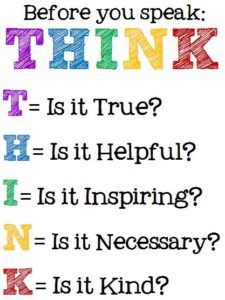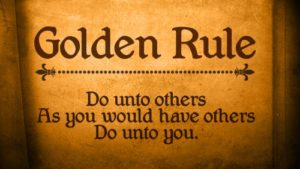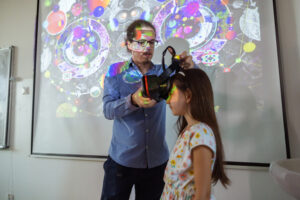13 Manners My Mom Taught Me That Affect Behavior
11/19/2016

My mom, Pat Konen, helped me to understand that manners are essential. Being a classroom teacher for over 30 years (Kindergarten, second grade, fourth grade, and a traveling science teacher) she understood that weaving manners into her instruction supported her classroom management and even more importantly, she understood it was a proactive way to get students to behave better. In talking with many of her former students, whom are mostly older than me, they remember the fun activities and ultimately the structure she provided for those activities in their kindergarten classroom. Within the first five seconds of proclaiming my mom was their teacher, I always get a smile first and many admit that she metaphorically "whipped them into shape!" It is so true that what you learn in kindergarten stays with you a lifetime.
Mom understood that education and learning experiences should be hands on and fun for learning to stick. She added in hands-science experiments, crafty art projects, and so much more with glue and glitter! Many teachers would steer away from daily hands-on learning because of the management of students and supplies; not my mom. She knew that having procedures, routines, and manners made her instruction easier. When she had classes where the student achievement was lackluster; she changed her game plan. She told me that many of those classes just needed to work on getting along with each other…this had to be done before she could ever worry about curriculum and content. I believe she was ahead of her time in so many areas.
In an Education World article based on a kindergarten research study, it was found that teaching manners can affect the behavior of students in a school. The study is similar to the philosophy based on the high energy, high expectations of Ron Clark! If you have not seen the Ron Clark Academy, I recommend reading, researching, or even visiting his school outside of Atlanta, GA. In Mr. Clark's book, Essential 55: An Award-Winning Educator's Rules for Discovering the Successful Student in Every Child, he profoundly states the 55 rules he used in a New York City School changed the culture and raised student achievement to unheard of levels.
Here are 13 manners that my mom taught me that I am teaching my students. These manners definitely have an effect on our school's culture and student achievement:
1: Be Kind
The number one thing my mom taught was to be nice to others and show kindness. I was lucky enough to watch her with her students. When students were unkind, she would take this on with students…one-on-one. She would then use the whole class to support these students with kindness. I was taught to be kind to all students, no matter their families' income, where they were from, or if they were mean to me.

2: If You Don't Have Something Nice to Say, Don't Say Anything At All
Many times we blurt out something without thinking of its implications. Nothing is more visible than watching our presidential candidates recently…especially one of them! It seems we don't listen very well anymore, but we listen to be heard. Sometimes listening means not responding immediately…especially if it isn't going to help! Last year I put a poster up outside my office with a great acronym: THINK!

3: Look at Someone When They Are Talking to You
Eye contact is a visual communication tactic that automatically shows respect. Think about all the students' communication with each other and with adults in which eye contact is not present. When we get eye contact, we automatically think the other person is truly listening to us. We must teach what that looks like…turn your body, raise your head, look at the other person's face, and even nod to let them know you are listening. Nodding doesn't necessarily mean you agree, but that you are listening and understanding what they are saying. Teaching to raise your eyebrows when you answer shows respect and positivity. It may sound crazy, but it is extremely difficult to be angry when answering if your eye brows are up….try it! Now try inflicting the last word in your sentence with a higher tone in your voice. Try this statement, "You may walk down the hall!" By using high eye brows and a higher tone level of voice inflection, you turn a request to change behavior into a positive statement that hopefully students will follow more effectively!

4: Use Please and Thank You
Probably the manner that is taught and reinforced the most by parents and teachers is the ability to say "please" when you offered something, and saying "thank you" when something is received. Some think this is a lost art in manners, but I see it is an opportunity to teach. If students don't use these "magic" words, then we must teach them how, when, and where they should be using these words! We need to model it from all adults in our building, then expect it, and finally, hold students accountable in using it.
5: Responding to Adults
Depending on your culture, dialect, and where you are from, responding to adults is an important sign of respect. Whether you say, "Yes, ma'am," and "Yes, sir," or simply use the person's last name, "No, Mrs. Smith," or "No, Mr. Konen," these show respect to the person you are talking with, as well as letting them know you are listening. This of course needs to be modeled and taught.

6: Be The Best You Can Be At All Times
My mom use to say, "Even when no one is looking, be the best you can be." I tended to get in a lot of trouble in many different places, so mom had to say this a lot to me. I sometimes think I am in my position at school because of Karma at times…a principal dealing with student behaviors! This is a powerful saying with students and if you are in education, you know we can't be everywhere with every child on our campus. We have to believe students are born to be the best they can be and if we model and teach this, we can pass it on to our students.
7: Tell the Truth
Telling the truth for me as a kid was difficult. I quickly found out that lying about something took the heat off on me, but when my mom learned that I had lied, I was in twice as much trouble. Likewise, in school being honest is sometimes hard for students. What we need to teach is that who we are as a person and what makes up our character is the ability to always tell the truth. The basic building block for all relationships is trust. Building trust means you tell the truth over time, and that you follow through with what you say you are going to do. These actions make telling the truth vital to students learning how to trust other students and adults.

8: Learn From Your Mistakes
You may wonder how this can be a manner, yet continuing to keep making mistakes and not learning from them is considered bad manners. Who you are over time shows your manners to others. If after being continually reminded to do something, you chose to not do it again, you are illustrating not being able to learn from your mistakes. I am pretty sure my mom had enough of me not picking up after myself, cleaning up my messes, or continually tormenting my teachers. I had a hard time learning from my mistakes. We can model and teach students that failure is just where the new learning goes. Failure should not be something we shy away from expecting, nor should it be something we withhold from our students. Students must understand failing is part of learning. I love this acronym for "FAIL."

9: Shake Hands When You Meet Someone
When first meeting someone a strong handshake, eye contact, and repeating the person's name is a powerful manner to learn! How many parents take the time to teach this? When a young student does this, your perception of the student is automatically engrained in your mind. Respect for the person is illustrated vividly when a student shakes hands. Teaching students to shake hands with new students or friends is just as powerful. It is a sign that tells them, "I want to get to know you," or as an adult, "I want to work for you!" Teaching students that an employer will remember you right away with a strong handshake makes this a necessary skill as an adult! My son shakes the hands of his football coaches after every game, and after almost every practice. His appreciation for the coaches and the opportunity to play varsity football is something he doesn't take for granted.

10: Appreciate the Food Made for You
The mantra that is probably the most hilarious that my mom taught was, "If you don't eat it, you will be wearing it." This was said when I didn't like a specific food item my mom had made for me. She had put time into cooking it for me and showing respect to her equated to trying some of the food she had cooked. This was considered good manners. I learned to appreciate not only the food made for me, but the time and effort it took to make it. I remember joking with her about where I would wear certain food items. I believed Brussel sprouts looked better on my shirt! I have since used this with my own kids, as well as with students…they laugh at first, but then they understand that it was someone's job was to prepare this food for them. Teaching our students, especially in the lunchroom, to try the food and to appreciate the people who prepared it is a life skill and manner we want for all our students to possess.

11: Take Turns
Whether it was with a toy, going down a slide, or getting water from the fountain, I had to learn how to take turns. I admit, I was not into sharing my toys very much as a kid, but my mom instilled in me patience and turn taking. This is a mega manner to teach students as most squabbles occur because someone gets to do something first: first in line, first to the pencil sharpener, first to the door, first to the ball, and so on. What if students said, "You may go ahead of me, I will wait." Wouldn't your head turn and say "What was that?" We can teach and model this with students, and when you see it…praise the heck out of it!
12: Respecting Others and Objects
Showing respect to my dad's pickup truck may not have been a priority as a recently licensed driver. But, this is another mega manner…respecting people and objects is something we start teaching when kids are quite young. We learn that how we treat people should be how we want to be treated: Golden Rule. Likewise, how we treat people's objects is how we would like our own objects to be treated. My mom ran a daycare while my sister and I grew up, and I know this was one of her main objectives as a provider. Parents knew that their child was learning this valuable manner each and every day in attendance.

13: Be Organized
You may ask, how is being unorganized "bad manners." When being unorganized affects others, it is definitely bad manners. When someone has to clean up after you, or you are late for an appointment, or you can't find something that someone else needs because of your lack of organization skills, you are exhibiting bad manners. Being organized says you are being respectful to others; organization is a sign of respect. Respecting people's time, effort, and efficiency relies on you being organized. This is difficult sometimes for students to understand, but teaching cause and effect can be quite powerful when learning this manner. My mom makes tons of lists, carries tape where ever she goes, and has many supplies in her purse which makes her one of the most organized and successful people I know. She modeled for me that being prepared is the ultimate manner for success; time up front gives you more time in the end!
Recently in my school, we took Ron Clark's 55 rules and created our own Lion's 19. These are 19 rules that we adopted from the Essential 55. We have taken these rules and taught one each day at the beginning of the school year. In addition, we have asked all staff members and students to recognize others in our school that are exemplifying these 19 rules. We then have students write down a student's name on a gold slip that illustrates one of the 19 Rules, the number on the Lion's 19 list, and a short description what they did. Then, we read these every morning on the PA to the whole school. Lastly, we post them on a bulletin board for all to see and read. To help promote these 19 rules, we are giving away one local high school football jersey each Friday to a student on one of the slips. There is much pride by the young Lions even though the jerseys are old, ripped, but washed well! This has created a powerful connection to what we are learning at the elementary level with our high school down the street! What essential manners will you teach your students?
- Learning How to Say No and Set Boundaries with Parents - November 21, 2022
- If You Had Only One Behavior Strategy to Use in Your Classroom, What Would It Be? - September 26, 2022
- Live Your Code: 7 Strategies That Will Help You Be the Most Effective Educator You Can Be - August 15, 2022










